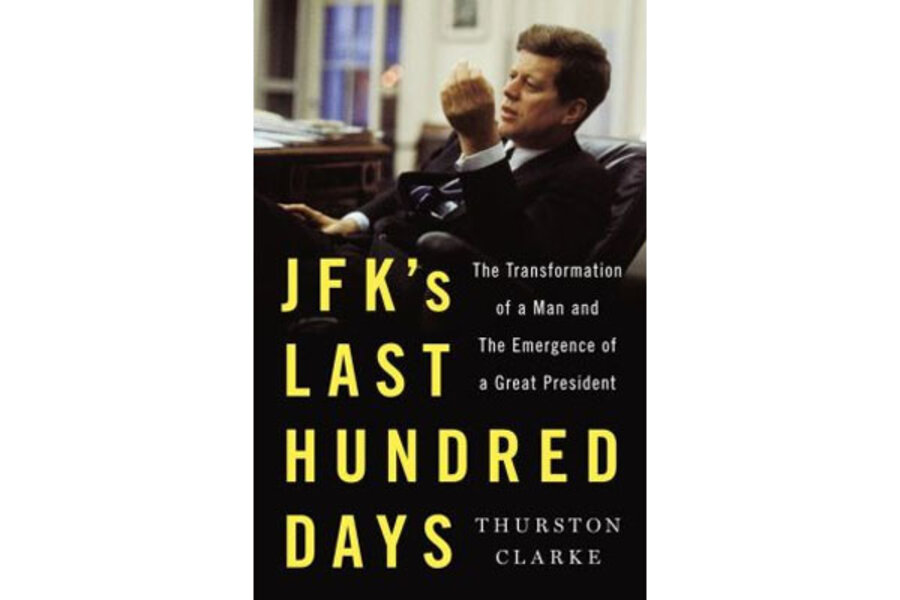JFK’s Last Hundred Days
Loading...
November marks the 50th anniversary of John F. Kennedy’s assassination in Dallas. That means an avalanche of books, documentaries, and articles can be expected in the months ahead, dissecting everything from the Zapruder film to the Warren Commission and beyond to the what-ifs of Kennedy’s Camelot.
But all of the upcoming retrospectives will be hard-pressed to match the haunting work of Thurston Clarke. Author of a well-received history of Bobby Kennedy’s 1968 campaign, which, like his older brother’s presidency, ended in assassination, Clarke makes a compelling case that President Kennedy came into his own in the 100 days before Lee Harvey Oswald murdered him in Dallas.
What makes the book work so well is its smart use of detail and fine balance of critique and praise. Clarke has an obvious affinity for JFK, but maintains an even-handed perspective.
JFK’s Last Hundred Days tells the story the title promises, beginning with the premature birth and, two days later, death of Patrick Bouvier Kennedy in Boston. The loss shattered the president and his wife, Jackie, but also brought them together.
As he does so often in this book, Clarke supports, with anecdotal evidence and reminiscences from friends and family, his belief that the serial philanderer-in-chief finally became a devoted husband in the last few months of his life.
But he refuses to spare JFK for his reckless ways, foibles, and miscalculations. Clarke writes of JFK’s trips, decisions, and appearances during the days between August and Nov. 22, 1963, using a meeting with an influential senator or the president’s crippled father to convey where Kennedy had been and where he was headed.
Kennedy went from a bumbling young president overwhelmed by the Bay of Pigs fiasco in Cuba and an extremely cautious approach in the White House to a decisive advocate for Civil Rights and a commander-in-chief privately bent on removing all military advisers from Vietnam and never allowing ground troops into Southeast Asia.
Equally impressive, he hit his stride with Soviet Premier Nikita Khrushchev, signing a nuclear test-ban treaty and building a rapport both leaders believed could reverse the Cold War.
Still, Clarke manages to avoid getting bogged down in too much diplomatic chatter, cables, and correspondence. In 400 pages, he packs a lot of information into a digestible form, combining the personal and the political to great effect.
Nodding to the work of fellow historian Robert Dallek, who Clarke praises in the acknowledgments, the book illustrates the day-to-day life of the president. Kennedy “was not a hypochondriac,” Clarke writes, but “merely someone who after a lifetime of illnesses and pains had become accustomed to seeking treatments for minor complaints.”
The president suffered from Addison’s disease, chronic diarrhea, poor vision, back pain, and allergies to dust and animals. Still, an exercise and rehab regimen undertaken in 1962 and 1963 left JFK feeling better than he ever had at the time of his death. (Kennedy was ill throughout his childhood, too.)
He came from a wealthy family, but retained his father’s disdain for showy affluence. Clarke notes Kennedy never allowed pictures to be taken of his Air Force One cabin because it looked “like a rich man’s plane.”
The president frowned on snobbery, even if Jackie did bring style and lavish spending into his orbit.
Of his predecessor, Dwight Eisenhower, JFK said, “He is a terribly cold man. All his golfing pals are rich men he has met since 1945 (when World War II ended with Ike as a national hero).”
On Vietnam, Kennedy, in Clarke’s view, and the opinion of others who worked in the White House, was waiting for re-election before ending America’s limited engagement. “We don’t have a prayer of prevailing there,” he said once. “Those people hate us.”
A tentative approach to Civil Rights morphed into passionate moral stance as Kennedy witnessed the horrors of Birmingham, Ole Miss, and other, literal Southern battlegrounds. He and Martin Luther King Jr. came to respect and admire one another after sharing a mutual wariness earlier in his presidency.
Interesting digressions can be found on most pages, from JFK’s lack of interest in TV (all but one of the White House sets were removed after the Eisenhowers left), to his hopes for a shared lunar mission with the Soviets to reduce costs. The man who pledged to put the first man on the moon saw little value in space exploration beyond Cold War braggadocio, something he had lost interest in after the test-ban treaty.
When he traveled, Kennedy kept a scale in tow to check his weight. He also avoided swimming in public, conscious and embarrassed of what he called his “Fitzgerald breasts.” As for the glamorous First Lady, she wore gloves to cover nicotine-stained hands and extra-wide shoes to flatter “her enormous feet.”
Late in the book, Clarke stumbles into hagiography by dismissing all of Lyndon Johnson’s legislative victories after Kennedy’s death. Instead, he cites comments by Congressional leaders at the time saying Kennedy’s legislative agenda would have passed if he had lived. Robert Caro’s most recent LBJ biography stacks the facts too high to let such a contention go by without considerable skepticism. For all his crudity and disastrous escalation in Vietnam, Johnson wielded legislative power with a skill that neither Kennedy nor any other president this side of FDR can match.
Even so, agree with him or not, Clarke has delivered a compelling history in an interesting manner, a difficult chore in itself. That he has done so while writing about the nation's most glamorized presidency borders on the miraculous.






